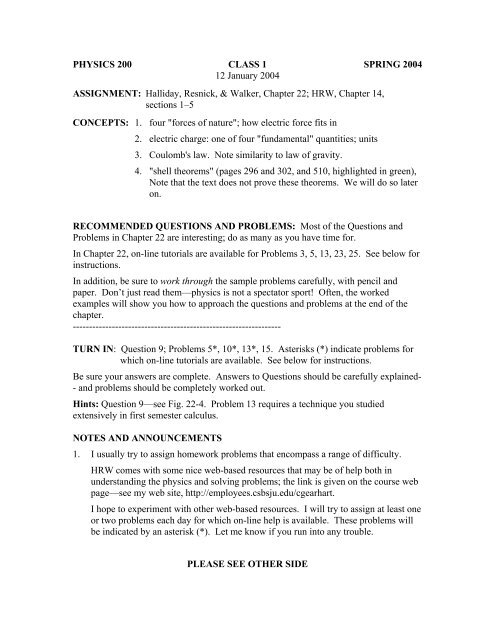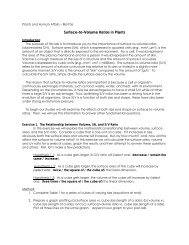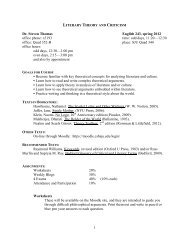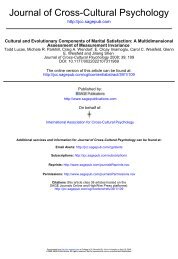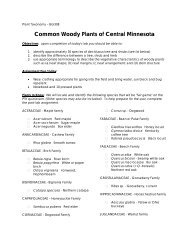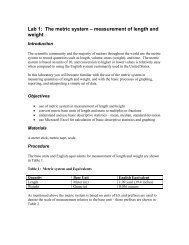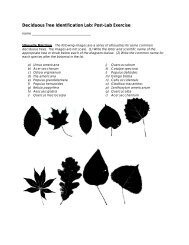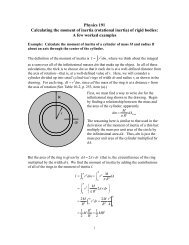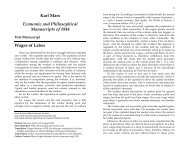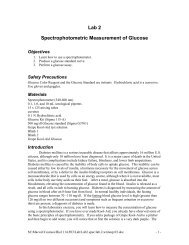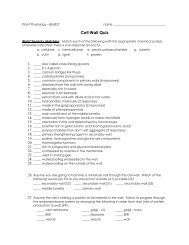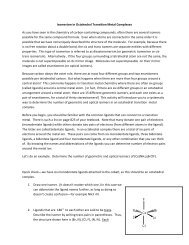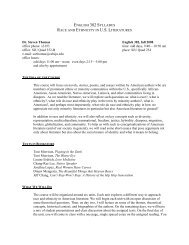PHYSICS 200 CLASS 1 SPRING 2004 ASSIGNMENT - Employees ...
PHYSICS 200 CLASS 1 SPRING 2004 ASSIGNMENT - Employees ...
PHYSICS 200 CLASS 1 SPRING 2004 ASSIGNMENT - Employees ...
You also want an ePaper? Increase the reach of your titles
YUMPU automatically turns print PDFs into web optimized ePapers that Google loves.
<strong>PHYSICS</strong> <strong>200</strong> <strong>CLASS</strong> 1 <strong>SPRING</strong> <strong>200</strong>412 January <strong>200</strong>4<strong>ASSIGNMENT</strong>: Halliday, Resnick, & Walker, Chapter 22; HRW, Chapter 14,sections 1–5CONCEPTS: 1. four "forces of nature"; how electric force fits in2. electric charge: one of four "fundamental" quantities; units3. Coulomb's law. Note similarity to law of gravity.4. "shell theorems" (pages 296 and 302, and 510, highlighted in green),Note that the text does not prove these theorems. We will do so lateron.RECOMMENDED QUESTIONS AND PROBLEMS: Most of the Questions andProblems in Chapter 22 are interesting; do as many as you have time for.In Chapter 22, on-line tutorials are available for Problems 3, 5, 13, 23, 25. See below forinstructions.In addition, be sure to work through the sample problems carefully, with pencil andpaper. Don’t just read them—physics is not a spectator sport! Often, the workedexamples will show you how to approach the questions and problems at the end of thechapter.----------------------------------------------------------------TURN IN: Question 9; Problems 5*, 10*, 13*, 15. Asterisks (*) indicate problems forwhich on-line tutorials are available. See below for instructions.Be sure your answers are complete. Answers to Questions should be carefully explained-- and problems should be completely worked out.Hints: Question 9—see Fig. 22-4. Problem 13 requires a technique you studiedextensively in first semester calculus.NOTES AND ANNOUNCEMENTS1. I usually try to assign homework problems that encompass a range of difficulty.HRW comes with some nice web-based resources that may be of help both inunderstanding the physics and solving problems; the link is given on the course webpage—see my web site, http://employees.csbsju.edu/cgearhart.I hope to experiment with other web-based resources. I will try to assign at least oneor two problems each day for which on-line help is available. These problems willbe indicated by an asterisk (*). Let me know if you run into any trouble.PLEASE SEE OTHER SIDE
<strong>PHYSICS</strong> <strong>200</strong> <strong>CLASS</strong> 2 <strong>SPRING</strong> <strong>200</strong>4(14 January <strong>200</strong>4)<strong>ASSIGNMENT</strong>: Text, Chapter 23, sections 1–6CONCEPTS: 1. Induced electric charge; electric dipoles.2. Electric Field -- Be sure you understand why we introduce this idea.Note that we can equally well speak of a gravitational field—this ideamay seem a little more intuitively reasonable at first.3. Lines of force. This concept was introduced by Michael Faraday inthe 19th century, and is a marvelous device for "visualizing" electricfields.4. binomial theorem (calculation on page 526) – it is an important andwidely used tool for doing approximations4. Concept of an integral as a device to “add up” infinitesimal pointcharges to find the field of an extended object.On-line tutorials: Chapter 23, Problems 13, 21, 23, 31, 39RECOMMENDED QUESTIONS AND PROBLEMS: Concentrate on the problemsfor sections 3–5 at the end of Chapter 23-----------------------------------------------------------------TURN IN: Chapter 23, Question G-23; Problems 10, 11, 13*; Extra Credit, Problem 16Please note: Questions and problems from the (green) Problem Supplement book have a“G” in front of them, as in Question G-23 above.NOTES AND ANNOUNCEMENTS1. Remember that on-line tutorials are available for the starred problems.2. Remember to follow the guidelines in the course outline for writing up homework.3. Problem 16 is moderately challenging. In order to approach it, it helps to understandin detail how HRW’s calculation with the binomial theorem works, even though thattheorem is not absolutely necessary for this problem. Note, for example, that thebook skips several steps between Equations 23-5 and 23-6. The book does notexpect that you will think those steps are obvious; it does expect you to workthrough the calculation on your own.I have put a few notes on the binomial theorem on the other side of this page.
2. I have asked you to read in Chapter 14 so that you can see for yourselves the stronganalogy between gravitational and electrical forces. For the time being I will assignproblems only from Chapter 22.3. I check my email regularly, including evenings. It's a good way to get through to mequickly—far more reliable than voice mail. I will be glad to try to answer questionsfrom the reading and homework assignments via email.4. Chapter 22 has two purposes. One is obvious—to introduce you to static electricityand to Coulomb's law in particular. The other is less obvious—to review themathematics of vectors, and be sure you understand them and know how to workwith them. Be sure you keep both purposes in mind!
<strong>PHYSICS</strong> <strong>200</strong> <strong>CLASS</strong> 3 <strong>SPRING</strong> <strong>200</strong>4(16 January 04)<strong>ASSIGNMENT</strong>: Text, Chapter 23, sections 6–9CONCEPTS: 1. Concept of an integral as a device to "sum" infinitesimal pointcharges to find the field of an extended object. Be sure you can workthrough in detail, understanding every step, the derivations andsample problems in sections 6–7, as well as the calculations in class.2. I will probably leave sections 8 and 9 pretty much to you. The firstmakes use of the ideas you studied last semester on constantaccelerations and forces. Section 9 is less straightforward—oneneeds to understand that it takes work to rotate an electric dipole in anexternal electric field; and hence, one can define a potential energy.You may already be familiar with these ideas—see Chapter 10,Sections 8–10 for a review.RECOMMENDED QUESTIONS AND PROBLEMS: Concentrate on the problemsfor sections 6 and 7; but have a look at the ones for 8 and 9 as well. Problem 44 might bea good one to do. On-line tutorials are available for Problems 13, 21, 23, 31, and 39.-----------------------------------------------------------------TURN IN: Chapter 23, Problems 19, 22, 23*,24, 39*NOTES AND ANNOUNCEMENTS1. This problem assignment is a challenging one. Do not wait until the last moment tostart! It may help to work through the derivations and sample problems in the text,as well as your class notes. Hints:• For problem 19, you may need to review the simple harmonic oscillator, whichyou studied last semester. The defining characteristic is that a particle in simpleharmonic motion obeys Hooke’s law, F = − kx, and that the angular frequencyω = k/m .Note that Eq. 23-6 gives the field along the axis of a charged ring. The result thisproblem asks you to prove is true only in the limiting case z
<strong>PHYSICS</strong> <strong>200</strong> <strong>CLASS</strong> 4 <strong>SPRING</strong> <strong>200</strong>4(20 January 04)<strong>ASSIGNMENT</strong>: Text, Chapter 23, sections 7–9Text, Chapter 24, sections 1–5. We will take two or three days on thischapter, so concentrate on the earlier sections for next time. Workthrough (don’t just read) the worked examples!CONCEPTS: 1. Electric flux.2. Gauss's Law. Be sure you understand that Gauss's Law is equivalent,both mathematically and physically, to Coulomb's Law. If they areequivalent, why do we need a second formulation?3. Gauss's Law will permit us to prove a couple of interesting claims:• We will be able to prove the two "shell theorems" we introducedin chapter 23. There are other ways of doing these proofs, butthis one is the simplest.• We will be able to show that if one has a charged conductor (forexample, a piece of copper on which we have placed someelectric charge), all the charge must reside on the outside surfaceof the conductor.RECOMMENDED QUESTIONS AND PROBLEMS: In chapter 23, be sure youunderstand how to do problems involving integration and the binomial theorem. Inchapter 24, concentrate on the problems and questions for sections 1–6. Problem 11 isespecially interesting—it involves very little calculation, but a good deal of thought.TUTORIALS AVAILABLE: Chapter 24, problems 7, 21, 41-----------------------------------------------------------------TURN IN: Chapter 23, Question 12; Problem 27; Extra Credit: Question 10Chapter 24, Question 3; Problems 5, 10NOTES AND ANNOUNCEMENTS1. I have asked you to read section 9 of chapter 23, but am only assigning one extracreditquestion (for which, as always, I will look for a clear, detailed explanation).We will look at this section again later in the semester, when we talk about magneticdipoles. For now, be sure you understand why an electric dipole tends to line upwith an external electric field. It may help to review the treatment of torque inChapters 11–132. The second lab will meet on days 4, 5 and 6 of cycle 2 (Friday, Monday, andTuesday, 23, 26, and 27 January). We will do Experiment 2, “Electrical Circuits.”Bring your lab manual, lab notebook, calculator, and so on with you.
<strong>PHYSICS</strong> <strong>200</strong> <strong>CLASS</strong> 5 <strong>SPRING</strong> <strong>200</strong>4(22 January 04)<strong>ASSIGNMENT</strong>: HRW, Chapter 24.CONCEPTS: 1. Gauss's law, and why it is equivalent to Coulomb’s law.2. "Gaussian surfaces." As you think about this idea, ask yourself therelated question of how one measures the area of an irregularly shapedsurface.3. idea of "electrostatic equilibrium"--charges in equilibrium don't movearound4. The electric field inside a conductor must be zero. Be sure youunderstand why.5. In electrostatics, the charge on a conductor must reside entirely on theoutside surface. Be sure you can use Gauss’s law to explain why.6. Use Gauss's Law to calculate electric fields for "symmetric"geometries.RECOMMENDED QUESTIONS AND PROBLEMS: Be sure you understand thesymmetry arguments used to apply Gauss’s law to plane, cylindrical, and sphericalgeometries, and see if you can do some of the problems for sections 7–9. I will assignmore problems along these lines next time.-----------------------------------------------------------------TURN IN: Chapter 24, Question G-25; Problems 7, 9, 15, 19, 25.For the question, remember that “G-” refers to the green supplementaryproblem book. As with all questions, be sure to explain your reasoningcarefully.NOTES AND ANNOUNCEMENTS1. The second laboratory meets days 4, 5 and 6, Friday, Monday and Tuesday 23, 26and 27 January. We will do Experiment 2, Electrical Circuits.2. First exam: We will spend Monday on Chapter 24, and then move on to Chapter 25.That chapter should take us about three days. This schedule should put the first examsometime the week of 2 February.
<strong>PHYSICS</strong> <strong>200</strong> <strong>CLASS</strong> 6 <strong>SPRING</strong> <strong>200</strong>426 January 04<strong>ASSIGNMENT</strong>: HRW, Chapter 24CONCEPTS: 1. Use Gauss’s Law to calculate the electric field of problems withplanar symmetry2. Use Gauss’s Law to calculate the electric field of problems withspherical and cylindrical symmetry.3. Proof of shell theorems—be sure you understand themRECOMMENDED QUESTIONS AND PROBLEMS: Do as many as you have timefor in Chapter 24. Be sure you can do problems involving plane, cylindrical, andspherical symmetry, and that you understand how and why these symmetry argumentswork.In addition, work through the Gauss’s law simulation on the HRW web site. Be sureyou do the “self-test” exercises.-----------------------------------------------------------------TURN IN: Chapter 24, Question G-30; Problems 26, 28, 29, 46 (part a only);Extra Credit: Problem 41Note that Question G-30 is related to last Friday’s demonstration. As withall Questions, be sure to explain your answer carefully.NOTES AND ANNOUNCEMENTS1. Remember that the laboratory meets today and tomorrow.2. The first examination will come after Chapter 25, which we will start onWednesday. It will take about three days. Possible dates are therefore Thursday,5 February or Monday, 9 February. The exam will cover Chapters 22 through 25in HRW, and will consist of questions and problems similar to those at the end ofthe chapters in HRW. You may bring to the exam one sheet of paper withanything you like written on it except solved problems and worked examples(that is, “sample problems”) from the text. Please turn in this sheet of paper withyour exam.As part of your preparation for the exam, do lots of problems! Concentrate on themore interesting ones--that is, do not concentrate on the problems that involve nomore that plugging numbers into formulas. In addition, have the important lawsand results we have derived under good control--be sure you really understandthem, so that you are not just reciting laws or equations that you don't quiteunderstand. Be sure you understand and can reproduce derivations of importantresults and special cases, and the like.
<strong>PHYSICS</strong> <strong>200</strong> <strong>CLASS</strong> 7 <strong>SPRING</strong> <strong>200</strong>4(28 January 04)<strong>ASSIGNMENT</strong>: HRW, Chapter 8 (review); Chapter 14, section 6;Chapter 25, sections 1–4Chapter 25 talks about electrical potential energy and the related ideaof electric potential. Before going to far in chapter 25, we will reviewthe ideas of potential and kinetic energy and conservation of energythat you studied last semester.CONCEPTS: 1. Potential Energy: Why is potential energy a useful idea? Why do webother with it? What kinds of potential energies do you know aboutalready?2. potential energy of a simple harmonic oscillator3. gravitational potential energy. Note that we have two cases:• near the surface of the earth• at arbitrary distances from the earth (chapter 14)4. electric potential; relation between potential and potential energyRECOMMENDED QUESTIONS AND PROBLEMS: Do enough problems fromChapters 8 and 14 to give you a thorough review of potential energy.Tutorials: Chapter 8, Problems 19, 23, 43, 57; Chapter 14, Problems 5, 11, 21, 39, 53;Chapter 25, Problems 17, 22, 37, 43-----------------------------------------------------------------TURN IN: Chapter 25, Problem 6; Chapter 8, problem 25; Chapter 14, problems 33, 39*NOTES AND ANNOUNCEMENTS1. Remember that the first exam will come after chapter 25.2. Hint for chapter 14, problem 39: Assume that the distance from the projectile to theearth will not be approximately constant, so that mgh will not give the potentialenergy. See if this assumption turns out to be correct. (There is an on-line tutorialfor this problem.)<strong>PHYSICS</strong> <strong>200</strong> <strong>CLASS</strong> 8 <strong>SPRING</strong> <strong>200</strong>3
<strong>PHYSICS</strong> <strong>200</strong> <strong>CLASS</strong> 8 <strong>SPRING</strong> <strong>200</strong>4(30 January 04)<strong>ASSIGNMENT</strong>: HRW, Chapter 25Be sure to work through the sample problems!CONCEPTS: 1. equipotential surfaces; be sure you understand why equipotentialsurfaces are perpendicular to lines of force, and how to prove it!2. potential of a point charge; finding the potential of an extendedcharge distribution by integration of infinitesimal point charges. Notethat the integrals are scalars, not vector integrals, and so are ofteneasier.3. relation between the electric field and the electric potential. Be sureyou can calculate the potential from the field (sec. 25.4) and viceversa (sec. 25.9)RECOMMENDED QUESTIONS AND PROBLEMS: Most of the problems in thischapter are interesting—do as many as you have time for.ON LINE TUTORIALS FOR: Chapter 25, Problems 17, 22, 37, 43-----------------------------------------------------------------TURN IN: Chapter 25, Problems 8, 21, 23, 28 and the following Question:Question: Can two different equipotential surfaces intersect? (Hint: This question isrelated to another one: Can two electric field lines of force intersect? It may be helpfulto think about this question in both contexts.NOTES AND ANNOUNCEMENTS1. The next laboratory will meet, Days 4, 5 and 6, Monday, Tuesday and Wednesday,2–4 February. We will do Experiment 3, the Oscilloscope.2. The first examination will be on Monday, 9 February. The exam will cover Chapters22 through 25 in HRW. The exam will consist of questions and problems similar tothose at the end of the chapters in HRW. You may bring to the exam one sheet ofpaper with anything you like written on it except solved problems and workedexamples (that is, “sample problems”) from the text. Please turn in this sheet ofpaper with your exam.As part of your preparation for the exam, do lots of problems! Concentrate on themore interesting ones--that is, do not concentrate on the problems that involve nomore that plugging numbers into formulas. In addition, have the important laws andresults we have derived under good control--be sure you really understand them, sothat you are not just reciting laws or equations that you don't quite understand. Besure you understand and can reproduce derivations of important results and specialcases, and the like.Please see other side
3. Hint on problem 23Note that you already have the potential of a point charge (derived in class) and thepotential for a dipole (Equation 25-30, which I haven't derived, but which I trust all ofyou will do—it would make a good exam question). Since the potentials are scalars,one can just add them.In the coordinate system chosen by the problem, the algebra is simplest if you choosethe middle charge as the point charge, and the other two as the dipole. If you makethis choice, NOTE THAT THE DEFINITION OF d IS DIFFERENT FROM THATOF EQ 25-30. You must make the appropriate transformation.One gets the same result if you choose the two bottom charges as the dipole, but thealgebra is a little more involved.
<strong>PHYSICS</strong> <strong>200</strong> <strong>CLASS</strong> 9 <strong>SPRING</strong> <strong>200</strong>43 February 04<strong>ASSIGNMENT</strong>: HRW, Chapter 25CONCEPTS: 1. potential of a point charge; finding the potential of an extendedcharge distribution by integration of infinitesimal point charges.Since the integrals are scalars, they are often easier to calculate.2. Potential of a charged conductor or conducting shell3. Surface charge density (and hence the electric field) is higher inregions where the "radius of curvature" is small. A demonstrationand our discussion in class should make this result plausible. See alsothe discussion in Section 25-10 of HRW.4. corona discharge—demonstration; relation to above5. Calculate the electric field by taking the derivative of the potentialRECOMMENDED QUESTIONS AND PROBLEMS: In preparation for the exam, workas many questions and problems as you have time for in Chapters 22–25.-----------------------------------------------------------------DO BUT DO NOT TURN IN: Chapter 25, Problems 33; and the following questions andproblems:Question: If the surface of a charged conductor is an equipotential surface, must thecharge be distributed uniformly over the surface? Hint: Recall today’s demonstration.Problem: Start from Eq. (25-37), which gives the potential on the axis of a charged disk,and calculate the field. See if your result agrees with the direct calculation of the fieldthat we did in an earlier chapter.Problem: A total charge Q is shared by two metal spheres of radii R 1 and R 2 . The twospheres are connected by a conducting wire of length L that is much larger than the tworadii. Find(a) the charge on eachsphere; and(b) the tension in theR 1R 2wire.Explain why weassume L is largeLcompared to the radii.NOTES AND ANNOUNCEMENTS1. Remember that the laboratories meet today and tomorrow.2. Remember that the first exam is scheduled for Monday, 9 February. See theassignment sheet from the last class for details.


